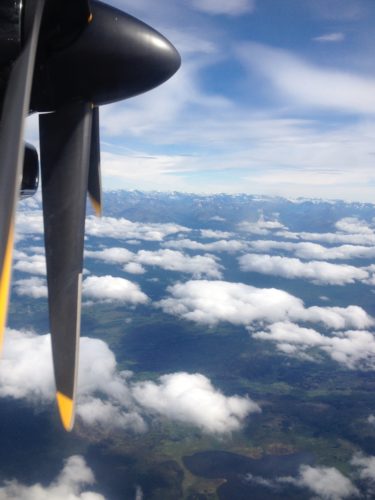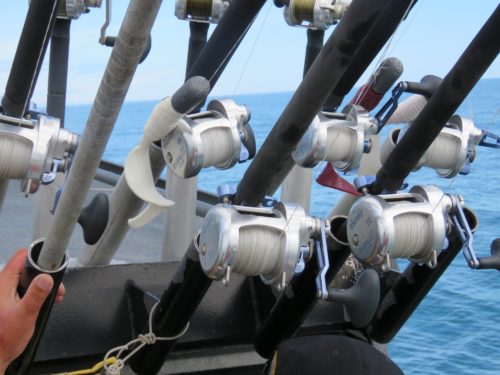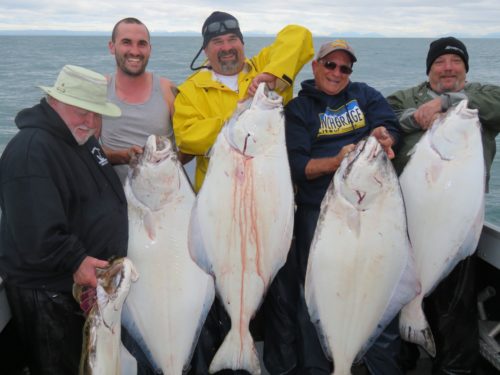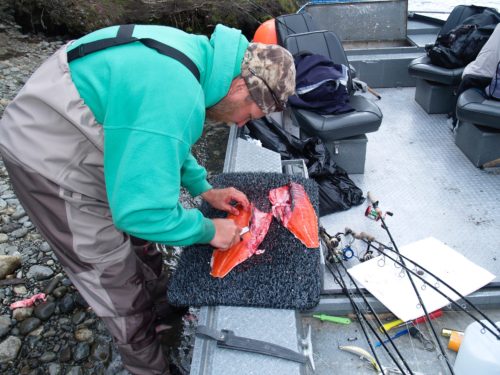The following appears in the October issue of Alaska Sporting Journal:
BY CAL KELLOGG
The Land of the Midnight Sun! For many outdoors enthusiasts living in the Lower 48, Alaska is the frontier of possibility.
Consider the unspoiled wilderness, snowcapped peaks, big glacial rivers, lakes, bays, inlets, the ocean, the aurora borealis, whales, sea otters, bald eagles, a long list of salmon species, huge lingcod, massive halibut, steelhead, trout, pike, moose, sheep, grizzlies, and more.
Growing up hunting and fishing in California, Alaska was my goal; experiencing it was my ambition. I wanted to fish its waters and hunt its mountains, and I figured by the time I’d reached my 50s I’d be a veteran of all things Alaska.
Well, I’ve now been to Alaska many times. So far all my trips have been focused on fishing. On many of those trips, I played host to anglers traveling up to Alaska from California. They were folks who had read my work and wanted to fish with me and the captains and outfitters I’d be fishing with. A lot of those visitors were Last Frontier first-timers.
From my experience I can tell you that even two dozen trips to Alaska – or even 10 times that number – don’t make you an “Alaska veteran.” The Last Frontier is just too big, too brawling and too diverse to master during your summer vacation. We are talking about a state that is 20 percent of the size of the Lower 48. That’s a lot of country to cover!
So you’re planning your first Alaskan fishing trip and are super excited, but you also don’t know what to expect, what to do and what to avoid. I can help, because I’ve been right where you are right now.
I’ve made my share of mistakes. When I went to Alaska the first time, one of the mistakes I made was buying over $1,000 in tackle and using next to none of it! In fact, some of it is still squirreled away in my garage in the original packaging. So I’ve learned some lessons. Consider some of the following caveats to have the perfect experience.

WHAT TO EXPECT
Expectations are a good place to begin. Here in the Lower 48 we envision Alaska as a sort of fishing nirvana. A place with rivers full of salmon, clouds of rockfish and halibut, and lakes where the trout have never seen a hook.
All this is true, but you’ve got to remember that Alaskan fish are just like fish anywhere else. When they bite, you can catch them. When they don’t want to go or when the weather doesn’t cooperate, you can get skunked in Alaska just like you can at your local lake or river. And then there are the salmon …
Everyone I’ve ever taken to Alaska anticipated wide-open fishing and limits every day; enjoying barn-burner salmon fishing is what makes Alaska so coveted by those wanting to fish there. The silvers here, the sockeye there, a few humpies, and a king or two checking in at over 40 pounds …
But the first thing to realize is that salmon move around. There are salmon runs. When they are running, you can catch them. Heck, you can catch a lot of them. But the flip side is true. If there are no salmon present, they are darn hard to hook. This is Alaskan salmon fishing rule No. 1.
The last time I was in Alaska I was on a boat with five other anglers. We were heading back in from the lingcod grounds when we spotted a grind of sea birds. The skipper eased in, we tossed out jigs and 20 minutes later we had full limits of 18 silver salmon to 13 pounds, plus a handsome bycatch of black rockfish up to about 9 pounds.
Sounds great, right? Well, it was, but I’ve fished the same area at the same time of the year and never saw a silver the entire time. Every year is different. Dare I repeat rule No. 1: To catch salmon, they have to be present.
There are also special regulations on salmon. I remember one day fishing from a jet boat on the Kenai. The plan was to throw spinners for river-run silvers. We got a few, but I led off the trip with 40-plus-pound kings on back-to- back casts. The king season was closed and the closure was so serious that we couldn’t even remove those fish from the water for a photo before releasing them. Therefore, rule No. 2 about Alaskan salmon fishing is that the season has to be open for the type of salmon that ends up on your line!
By the way, as long as we are talking about salmon, do you know what native Alaskans’ favorite salmon species is? It’s not silvers or kings. It’s the sockeye, or as they are called up north, “reds.”
Sockeye are hands down the best- eating Alaskan salmon and they exist in prolific numbers. If you want good eating and lots of fun, plan your trip when the sockeye are running!
Interestingly, the bigger the river, the bigger the sockeye that inhabit it. On small creeks, I’ve enjoyed action on 3- to 6-pounders, but on the large Kenai River those salmon run from 6 to 11 pounds.
If I were looking for sockeye and I wanted to bring salmon meat home, I’d focus my efforts on big water and the bigger-model reds that inhabit those larger rivers.

INFORMATION IS POWER
I wouldn’t advise you to visit Alaska for the first time on your own. You’ll have a better experience in the hands of a quality lodge or knowledgeable outfitter. They’re a great way to get your feet wet and set yourself up for success should you decide to strike out on your own adventure in the future.
You’ll want to chat with several different operations before you put down your money. What do you want to do? Do you want to fish the Interior from a bush plane? Is river salmon fishing your goal? Are you interested in saltwater fishing?
Once you’ve found a business that seems to be a good fit, put down your deposit and keep on asking questions. Most outfitters will provide you with a fact sheet, but questions to sort out include: How does dining work? Do you need tackle? How does transportation to and from the lodge work? What’s included and what’s not included? Do you need waders and raingear? How do you bring your catch home?
Most places I’ve visited provide waders and clothing for inclement weather, but I still bring my own. I have size 15 feet, so I ensure success by bringing my own waders and/or rubber boots. I take the same approach with wet weather gear. Sorting out how lodging works is a great question that often slips through the cracks. If you go alone or with a partner, will you have a private room or is a dorm-type situation in effect? I’ve seen trips ruined when two strangers were paired in a room and one of them turned out to be a big-time snorer.


THE WEATHER FACTOR
The one thing you can count on when it comes to the weather in Alaska is that it can and will change on a dime. In my experience, fair sunny days are the exception. Most of the time you can expect mild temperatures and periods of rain. Typically it’s not hard winter-type rain. It’s usually gentle off-and-on showers, with a lot of overcast skies.
Honestly, one of the things I really like about going to Alaska in July or August is escaping the 100-plus- degree temperatures when I fly out of California’s Sacramento International Airport and arriving to temps in the 60s when I land in Homer or Juneau.
With the threat of daily rain and being constantly in and around water, I wouldn’t go to Alaska without a waterproof bag, preferably a backpack, since a pack frees your hands to do other things. That bag is where you’ll keep your phone, cameras, dry clothes and anything else you don’t want soggy and wet.
In terms of clothing, comfort is king and generally speaking quality is better than quantity. A couple changes of “field” clothes and a set of comfortable “lounging around the lodge” duds are all you need. Leave the cotton at home. If there was ever a place for those high- tech space age wicking weaves and fleeces, Alaska is it. Think light, dry and windproof.
I’d say that 90 percent of the time that I’ve been in Alaska, if I wasn’t wearing waders, I was wearing rubber deck boots. This being the case, I travel with three pairs of quality over-the-calf socks. This way I always have two dry pairs and one drying out.
It’s nice to have a set of slippers or rubber clogs to wear around the lodge. This is something a lot of folks overlook in the planning process.
Headgear is another area that can slip through the cracks. I’m a ball cap guy, so I typically have one or two of those, but I wouldn’t go north without a beanie. They keep your ears warm and they work well when you have the hood up on your rain jacket and, you know, the sky decides to dump rain as you’re fighting that 125-pound halibut!

BE A SEA-WORTHY ANGLER
As long as we are on the deck fighting halibut, let’s think about motion sickness. If you are going on the ocean or if you are going to be flying in a small plane, bring some motion sickness medication.
I know you sailed with Capt. Kid and never got even a slight wave of queasiness. Well, you’re paying a lot of money to experience Alaska. The days are long and you’re going to be tired and worn down from all the fun. The last thing you want to do is spend your time feeling sick, or worse, getting sick. I’ve seen it, so take the pills or wear the patch and have a good time!
ROLL WITH THE PUNCHES
Alaska is inspiring, but it can also be a harsh, unpredictable wilderness. Never forget that! There will be days when planes don’t fly and boats don’t run because the weather that had been fair took a turn for the worse when a front comes knocking out of the North Pacific.
I’ve spent my share of days tossing spinners in coastal rivers for a chance at a silver salmon when I’d actually been planning to be 70 miles out on the Gulf of Alaska dropping jigs toward massive lingcod. You’ve got to be flexible at such times and not let weather- and equipment- dictated changes get you down.
On one of those days when I got blown off the salt, I caught a 15-pound silver and on another we had a 70-plus-inch bull moose walk out into a meadow for a photoshoot. The moral of the story is this: When the weather gods give you lemons, roll with the punches and you might end up hanging out with a record-book moose, or perhaps posing with the biggest silver salmon you’ve ever seen! ASJ
Editor’s note: Cal Kellogg is a longtime Northern California outdoor writer who contributes to ASJ’s sister magazine, California Sportsman. Subscribe to his YouTube channel Fish Hunt Shoot Productions at youtube.com/user/KelloggOutdoors.
Credit: Source link






























